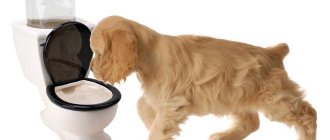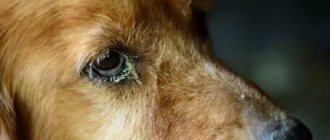Owners can easily notice some pathological changes in a pet’s body on their own – by looking at excrement. Their consistency should be soft, oblong in shape, and dark brown in color. If your dog's poop turns white, this is a serious cause for concern.
Possible types of white stool in dogs
A preliminary diagnosis can be made by the color and consistency of feces. Some causes of stool lightening are completely harmless, so don’t panic ahead of time.
By shade
The noble chocolate color is the result of the work of bile, an important pigment involved in digestion. Its lack in the intestines leads to the lightening of excrement to:
- white-yellow;
- white-green;
- completely white, that is, colorless.
In the first case, there is a high probability of helminthic, tick-borne and viral invasion, as well as disturbances in the functioning of the pancreas. In the second case, it is worth checking the functioning of the gallbladder and making sure that the pet’s food does not contain dyes.
The third case is the most dangerous. Complete loss of color is typical for advanced pathologies, when the flow of bile is completely blocked. The animal must be shown to a veterinarian as soon as possible.
By consistency
Excessive dryness or excess moisture, turning feces into shapeless slurry, should alert the owner. Lightened pet stool can be:
- Liquid. Indicates disturbances in the functioning of the pancreas and liver. Sometimes it occurs due to improper feeding, which negatively affects the functioning of the gastrointestinal tract.
- Slimy. Characteristic of helminthiases and diseases of the colon, as well as an abundance of stringy meat in the diet.
- With a white coating while maintaining its shape or crumbly and hard. It occurs with an illiterate menu, replete with cartilage, veins and bones.
- With white splashes with a slight change in the main color. The grains, which resemble small grains, occur when infected with worms or due to digestive problems that impair the digestion of food.
The causes of dry and loose stools, as well as their lightening, can be harmless and pathological. In the first case, the owner can cope with the problem on his own, but in the second, he will have to contact a veterinarian.
Safe reasons for lightening stool
If, apart from lightening, no other alarming symptoms are observed, then you can postpone contacting the veterinary clinic. In such cases, white feces in a dog are due to the following reasons:
- Regular consumption of bones. Eliminating these spicy and hard foods returns the usual consistency and color within a few days.
- Dehydration. This problem is common in animals that eat dry food. It takes much more liquid to digest it. When there is a lack of moisture, the body borrows reserves from its own cells, turning feces into a dry, crumbly substance.
- Long-term use of medications (Smecta, Augmentin) that affect liver function. After treatment is completed, the pet must take a course of lactobacilli to normalize lost functions.
- Excess animal fats in the diet. Pork, lard and dairy products with high fat content are poorly absorbed by the dog’s body, so veterinarians recommend excluding them from the diet.
If the suggested tips do not help, and your pet continues to defecate white feces, contact your veterinarian. Some pathologies occur in a latent form, so they can only be detected using laboratory diagnostics.
Pet health indicator
Normally, dogs' feces should be dark brown or tan in color. They acquire this color due to their high bile content. It plays an important role in digestion by dissolving food particles in the small intestine. In this case, all unnecessary residues are removed from the pet’s body naturally.
Thus, if the animal’s stool color suddenly changes, it is necessary to look for the cause and begin treatment. Typically, such a symptom is the first “bell” of a pathology developing in the dog’s body. That is why contacting a specialist in this situation will be mandatory.
We recommend this article:
How to Recognize Symptoms and Provide Treatment for Gastritis in Dogs
Pathologies requiring treatment
Since the liver is responsible for producing the usual color of excrement, most pathologies lie in it and adjacent organs: the gallbladder and pancreas. One of the most dangerous causes is a malignant neoplasm, which causes disruption in the functioning of the entire body.
Pathologies requiring treatment can be recognized by accompanying symptoms. If your pet is vomiting, feels weak and is not eating well, do not hesitate to get diagnosed. Without timely help, the disease can cause complications.
Liver diseases
Liver diseases are accompanied by lack of appetite, abdominal pain and bloating. During inflammatory processes, the animal's temperature rises. Most often diagnosed:
- hepatitis
– inflammation of hepatocytes (liver cells);
- fibrosis
– reversible excess formation of connective tissue on hepatocytes with loss of their functionality;
- cirrhosis
– an advanced form of fibrosis that is irreversible.
Delayed treatment of these pathologies can result in renal failure, glaucoma and acute toxicosis. The animal risks dying from anemia, internal bleeding or hepatic coma.
Gallbladder diseases
If the liver is responsible for the production of bile, then the gallbladder is responsible for its accumulation. Disturbances in this reservoir lead to the following diseases:
- cholecystitis - inflammation of the gallbladder, accompanied by fever and mucous vomiting;
- gallstone disease - an accumulation of stones or sand that injure the mucous membrane of the gallbladder;
- compression of the bile ducts.
If the stones completely block the ducts, then all the bile accumulates inside. Due to stagnation, urine changes color to bright orange. The mucous membranes turn yellow, and mucus and streaks of blood appear in the stool.
Pancreatitis
Inflammation of the pancreas makes it difficult to digest food. Food fragments are passed out along with feces, so some nutrients are not absorbed. Despite this, digestive enzymes continue to be produced. They accumulate in the pancreas and gradually digest it.
The disease is accompanied by vomiting, bloating and pain. The sick animal is depressed and refuses to eat, as attacks occur soon after feeding.
When to go to the vet
It is necessary to consult a doctor if the animal’s health has deteriorated sharply: the dog completely refuses to eat and drink, does not rise from its seat, and has a fever. You should not delay going to the vet if you are pregnant. Timely treatment will not only help the mother recover, but will also save the puppies. A visit to the clinic is required if the dog has had similar health problems in the past or has additional diseases.
High temperature is a reason to see a doctor
Carrying out diagnostics
To determine the cause of the illness and the condition of the internal organs, the pet will have to undergo a comprehensive diagnosis. It includes the following research methods:
- stool analysis, which helps detect toxins or other dangerous substances;
- urine analysis to determine problems in the genitourinary system;
- a blood test necessary to detect deviations in baseline indicators;
- Ultrasound, detecting inflammation, neoplasms and stones;
- X-ray showing pathological changes in internal organs;
- liver biopsy, determining the presence of malignancy of the tumors found.
With timely treatment, all of these diseases can be treated. Even cirrhosis turns out to be reversible, but only at an early stage - when only a small part of the hepatocytes is damaged.
Solution
After diagnosis, the problem is eliminated by treating the found disease with medications or surgery. It is equally important to review the existing diet in order to reduce the load on the affected organs.
Treatment of diseases
Surgical intervention is used only in the most severe cases: gallstone disease and neoplasms. If the stones in the gallbladder are represented by sand, then it is removed with the help of special medications and a therapeutic diet.
It is also worth refusing surgery if there are metastases. Excision of the tumor in such cases carries many risks, so surgery is unjustified.
Inflammatory diseases are treated at home with the following medications:
- antibiotics (Trichopol, Trimethoprim, Cephalexin) that fight bacterial infections;
- choleretic (Allohol, Ursosan, Holosas), increasing the production of bile;
- antispasmodics (No-shpa, Baralgin, Papaverine), which relieve pain;
- hepatoprotectors (Covertal, Thiotriazolin, Hepatovet), restoring liver cells;
- enzymatic (Mezim, Creon), normalizing the natural microflora in the gastrointestinal tract.
Before recovery, you will have to undergo several tests to ensure the effectiveness of the therapy. Pets with growths that cannot be removed will need to visit the veterinarian regularly even after the condition improves.
Diet adjustments
When feeding naturally, fatty fermented milk products, smoked meats, lard, bones, pasta, as well as fruits and vegetables without heat treatment should be excluded from the diet. The new diet should consist of:
- boiled lean meat (chicken, turkey);
- boiled vegetables (zucchini, carrots);
- light meat and fish broths;
- watery cereals (buckwheat, oatmeal);
- fermented milk products (cottage cheese, yogurt, kefir) with low fat content.
If the animal eats dry food, then preference should be given to a medicinal line recommended for digestive problems, at least premium class. Cheap economy-class food should be avoided: they contain a lot of salts and sugars, and their nutritional value is not enough for proper nutrition.
Feeding should be fractional. Food is given 5-6 times a day in small portions. This supply eliminates the feeling of hunger, which is typical for too long breaks, and reduces the load on the gastrointestinal tract. Additionally, it is recommended to drink a decoction of chamomile. It has an antibacterial effect and cleanses the liver and gallbladder of toxins.
Owner behavior - prompt assistance
If you see white feces on your dog for the first time, there is no need to panic. Analyze all the reasons for its appearance and observe the animal for 2-3 days. If your dog's stool does not change and his behavior becomes alarming, consult a doctor.
Before prescribing treatment, the veterinarian will ask the animal to conduct the following tests:
- urine and blood to identify inflammatory processes and the condition of the liver; in difficult cases, instead of a general study, a biochemical study will be performed;
- stool and biochemical urine analysis to determine the condition of the pancreas;
- if neoplasms are suspected, ultrasound of the abdominal cavity;
- X-ray of the liver or in some cases a biopsy.
Based on research results, doctors prescribe treatment in several areas:
- Antibiotic therapy (Trichopol, Cephalexin).
- Choleretic (Allohol, Holosas).
- Hepatoprotectors (Hepatoject, Hepatovet).
- Antispasmodics and analgesics (No-Shpa, Baralgin, Butofanol).
- Enzymes (Mezim, Creon).
If the presence of a cyst or cancerous tumor in an animal’s body is confirmed, surgery is always performed.











